电子科技大学:《材料设计与计算 Materials Design and Computation》课程教学资源(课件讲稿)MDC 02 DFT(1/3)
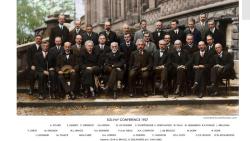
SOLVAY CONFERENCE 1927 colourized by pastincolour.com A.PICARD E.HENRIOT P.EHRENFEST Ed.HERSEN Th.DE DONDER E.SCHRODINGER E.VERSCHAFFELT W.PAUL W.HEISENBERG R.H FOWLER L.BRILLOUIN P.DEBYE M.KNUDSEN W.L.BRAGG H.A.KRAMERS P.A.M.DIRAC A.H.COMPTON L,de BROGLE M.BORN N.BOHR I.LANGMUIR M.PLANCK Mme CURIE H.A.LORENTZ A.EINSTEIN P.LANGEVIN Ch.E.GUYE C.T.R.WILSON O.W.RICHARDSON Absents:Sir W.H.BRAGG.H.DESLANDRES et E.VAN AUBEL
经典物理学剩 下的两朵乌云 量子力学 的发展

Schrodinger's equation in quantum mechanics Schrodinger equation as Newton's law in classical mechanics Schrodinger part of a monument in front (wave)Equation atoms,molecules,and subatomic particles of Warsaw University's free,bound,or localized Centre of New Technologies The linear partial differential equation describes the wave-function changes over time of a physical system in which quantum effects,such as wave-particle duality,are significant -气阿6可 The Nobel Prize in Physics defines the state of the system at each spatial 1933 position,and time(also called a "state function" dA:BA
Schrödinger (wave) Equation The Nobel Prize in Physics 1933 Schrödinger equation as part of a monument in front of Warsaw University's Centre of New Technologies Schrödinger's equation in quantum mechanics = Newton's law in classical mechanics atoms, molecules, and subatomic particles free, bound, or localized The linear partial differential equation describes the wave-function changes over time of a physical system in which quantum effects, such as wave–particle duality, are significant. defines the state of the system at each spatial position, and time (also called a "state function")
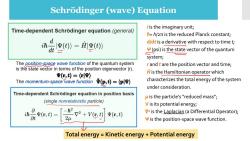
Schrodinger (wave)Equation iis the imaginary unit; Time-dependent Schrodinger equation(general) h=h/2nt is the reduced Planck constant; 2 h证更()=(④》 d/dt is a derivative with respect to time t; (psi)is the state vector of the quantum system; The position-space wave function of the quantum system rand t are the position vector and time; is the state vector in terms of the position eigenvector Ir), s,均=〉 Ais the Hamiltonian operator which The momentum-space wave function p,t)=〉 characterizes the total energy of the system under consideration. Time-dependent Schrodinger equation in position basis u is the particle's"reduced mass"; (single nonrelativistic particle) V is its potential energy; h 亚(r,t)= V2 is the Laplacian (a Differential Operator); 8t 2μ 亚(r,t) is the position-space wave function. Total energy Kinetic energy Potential energy
i is the imaginary unit; ħ= h/2π is the reduced Planck constant; d/dt is a derivative with respect to time t; Ψ (psi) is the state vector of the quantum system; r and t are the position vector and time; Ĥ is the Hamiltonian operator which characterizes the total energy of the system under consideration. μ is the particle‘s “reduced mass”; V is its potential energy; ∇ 2 is the Laplacian (a Differential Operator); Ψ is the position-space wave function. Total energy = Kinetic energy + Potential energy The position-space wave function of the quantum system is the state vector in terms of the position eigenvector |r⟩, Schrödinger (wave) Equation The momentum-space wave function
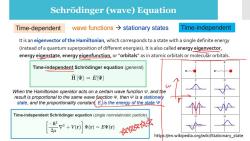
Schrodinger (wave)Equation Time-dependent wave functions>stationary states Time-independent It is an eigenvector of the Hamiltonian,which corresponds to a state with a single definite energy (instead of a quantum superposition of different energies).It is also called energy eigenvector, energy eigenstate,energy eigenfunction,or"orbitals"as in atomic orbitals or molecular orbitals. Time-independent Schrodinger equation(general) 庄|亚)=E平) When the Hamiltonian operator acts on a certain wave function w,and the result is proportional to the same wave function w,then w is a stationary state,and the proportionality constant,E,)is the energy of the state y. Time-independent Schrodinger equation(single nonrelativistic particle) [p2+v小=5 )牧效来 https://en.wikipedia.org/wiki/Stationary_state
Schrödinger (wave) Equation wave functions → stationary states It is an eigenvector of the Hamiltonian, which corresponds to a state with a single definite energy (instead of a quantum superposition of different energies). It is also called energy eigenvector, energy eigenstate, energy eigenfunction, or “orbitals” as in atomic orbitals or molecular orbitals. Time-dependent Time-independent When the Hamiltonian operator acts on a certain wave function Ψ, and the result is proportional to the same wave function Ψ, then Ψ is a stationary state, and the proportionality constant, E, is the energy of the state Ψ. https://en.wikipedia.org/wiki/Stationary_state

Schrodinger (wave)Equation TAUSEN口 [p+g-w 1▣a回 SCHILLING 1000 YG,2,,rw)=EΨ'(,2,rw) external potential e--e-interaction ·平cannot be found analytically complete "numerical"solution is possible but inefficient ·Complexity: basis set sizeNumber of electrons Hsrd problem tosve boQ@ve队 many electron system Schrodinger equation
Schrödinger (wave) Equation • Y cannot be found analytically • complete “numerical” solution is possible but inefficient • Complexity: basis set sizeNumber of electrons Hard problem to solve Schrödinger equation
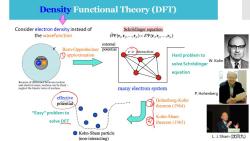
Density Functional Theory (DFT) Consider electron density instead of Schrodinger equation the wavefunction A(rz....x)=EV(2.Ix) external Born-Oppenheimer potential e-e ihteraction approximation Hard problem to nucleus W.Kohn solve Schrodinger equation Because of difference between nucleus and electron mass,nucleus can be fixed neglect the kinetic term of nucleus. many electron system P.Hohenberg effective potential. Hohenberg-Kohn theorem(1964) "Easy"problem to Kohn-Sham solve DFT theorem(1965) OKohn-Sham particle (non-interacting) L.J.Sham(沈吕九)
Density Functional Theory (DFT) Consider electron density instead of the wavefunction Kohn-Sham theorem (1965) Hohenberg-Kohn theorem (1964) L. J. Sham (沈吕九) P. Hohenberg “Easy” problem to solve DFT Hard problem to solve Schrödinger equation W. Kohn Born-Oppenheimer approximation
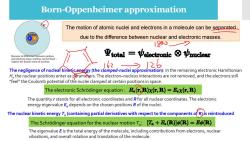
Born-Oppenheimer approximation The motion of atomic nuclei and electrons in a molecule can be separated due to the difference between nuclear and electronic masses. 18 Because of difference between nucleus 亚total=electronic⑧mulear and electron mass,nucleus can be fixed- neglect the kinetic term of nucleus. 162,,今126 The negligence of nuclear kinetic energy(the clamped-nuclei approximation):In the remaining electronic Hamiltonian He the nuclear positions enter as parameters.The electron-nucleus interactions are not removed,and the electrons still "feel"the Coulomb potential of the nuclei clamped at certain positions in space. The electronicSchrodinger equation:H,R)x(,R)=Ex(,R) The quantity r stands for all electronic coordinates and R for all nuclear coordinates.The electronic energy eigenvalue Ee depends on the chosen positions R of the nuclei. The nuclear kinetic energy T(containing partial derivatives with respect to the components of R)is reintroduced The Schrodinger equation for the nuclear motion T:[T+Ee(R)](R)=E(R) The eigenvalue E is the total energy of the molecule,including contributions from electrons,nuclear vibrations,and overall rotation and translation of the molecule
Born-Oppenheimer approximation The motion of atomic nuclei and electrons in a molecule can be separated due to the difference between nuclear and electronic masses. The electronic Schrödinger equation : The negligence of nuclear kinetic energy (the clamped-nuclei approximation): In the remaining electronic Hamiltonian He the nuclear positions enter as parameters. The electron–nucleus interactions are not removed, and the electrons still "feel" the Coulomb potential of the nuclei clamped at certain positions in space. The Schrödinger equation for the nuclear motion Tn : The quantity r stands for all electronic coordinates and R for all nuclear coordinates. The electronic energy eigenvalue Ee depends on the chosen positions R of the nuclei. The nuclear kinetic energy Tn (containing partial derivatives with respect to the components of R) is reintroduced The eigenvalue E is the total energy of the molecule, including contributions from electrons, nuclear vibrations, and overall rotation and translation of the molecule
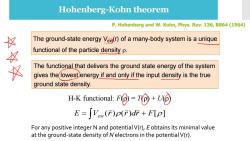
Hohenberg-Kohn theorem P.Hohenberg and W.Kohn,Phys.Rev.136,B864(1964) The ground-state energy Vax(r)of a many-body system is a unique functional of the particle density p. 区 The functional that delivers the ground state energy of the system gives the(lowestenergy if and only if the input density is the true ground state density. H-K functional: E=∫Ve(F)p(F)df+F[p] For any positive integer N and potential V(r),E obtains its minimal value at the ground-state density of N electrons in the potential V(r)
Hohenberg-Kohn theorem The ground-state energy Vext(r) of a many-body system is a unique functional of the particle density . H-K functional: F(ρ) = T(ρ) + U(ρ) E V (r)(r)dr F[] = ext + P. Hohenberg and W. Kohn, Phys. Rev. 136, B864 (1964) The functional that delivers the ground state energy of the system gives the lowest energy if and only if the input density is the true ground state density. For any positive integer N and potential V(r), E obtains its minimal value at the ground-state density of N electrons in the potential V(r)
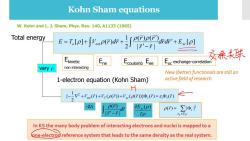
Kohn Sham equations W.Kohn and L.J.Sham,Phys.Rev.140,A1133(1965) Total energy E=+jvrI2w+回 Ekinetic 安杂关联 -ne Ecoulomb E C exchange-correlation vary p non interacting New(better)functionals are still an 1-electron equation(Kohn Sham) active field of research 抖 ←2+n)+e(pF》+y.py冲,(=GΦ. -Zl p() E(p) pr)=∑1D,P ap Ei≤EF In KS the many body problem of interacting electrons and nuclei is mapped to a one-electrop reference system that leads to the same density as the real system
Kohn Sham equations [ ] | | ( ) ( ) 2 1 [ ] ( ) o ext Exc drdr r r r r E T V r dr + − = + + Total energy Ekinetic non interacting Ene Ecoulomb Eee Exc exchange-correlation 1-electron equation (Kohn Sham) ( ) ( ( )) ( ( ))} ( ) ( ) 2 1 { 2 V r V r V r r r ext C xc i i i − + + + = = i EF i r 2 ( ) | | vary W. Kohn and L. J. Sham, Phys. Rev. 140, A1133 (1965) dr r r r | − | ( ) ( ) Exc -Z/r New (better) functionals are still an active field of research In KS the many body problem of interacting electrons and nuclei is mapped to a one-electron reference system that leads to the same density as the real system
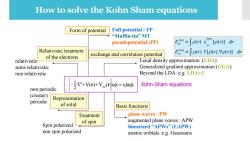
How to solve the Kohn Sham equations Form of potential Full potential FP “Muffin-tin”MT pseudopotential (PP) Egr∫or)spr)dr Relativistic treatment exchange and correlation potential EGGA∫pr)F[p(r,Vp(r】dir of the electrons relativistic Local density approximation (LDA) semi-relativistic Generalized gradient approximation(GGA) non relativistic Beyond the LDA:e.g.LDA+U non periodic -]V+V(r)+V.(rjok-gkpk Kohn-Sham equations (cluster) periodic Representation of solid Basis functions Treatment plane waves PW augmented plane waves:APW Spin polarized of spin linearized“APWs”(LAPW) non spin polarized atomic oribtals.e.g.Gaussians
1 2 ²+V(r)+Vxc(r)ik = ikik relativistic semi-relativistic non relativistic Full potential : FP “Muffin-tin” MT pseudopotential (PP) Local density approximation (LDA) Generalized gradient approximation (GGA) Beyond the LDA: e.g. LDA+U Spin polarized non spin polarized non periodic (cluster) periodic plane waves : PW augmented plane waves : APW linearized “APWs” (LAPW) atomic oribtals. e.g. Gaussians Basis functions Treatment of spin Representation of solid Form of potential exchange and correlation potential Relativistic treatment of the electrons Kohn-Sham equations How to solve the Kohn Sham equations E r F r r dr E r r dr GGA xc xc LDA xc ( ) [ ( ), ( )] ( ) [ ( )] hom.
按次数下载不扣除下载券;
注册用户24小时内重复下载只扣除一次;
顺序:VIP每日次数-->可用次数-->下载券;
- 电子科技大学:《材料设计与计算 Materials Design and Computation》课程教学资源(课件讲稿)MDC 01 Introduction(张妍宁).pdf
- 《材料设计与计算 Materials Design and Computation》课程教学资源(参考书籍)DENSITY FUNCTIONAL THEORY - A Practical Introduction(DAVID S. SHOLL、JANICE A. STECKEL).pdf
- 电子科技大学:《材料分子结构分析 Molecular Structure Analysis of Materials》课程教学资源(课件讲稿)第九章 热分析 Thermal analysis.pdf
- 电子科技大学:《材料分子结构分析 Molecular Structure Analysis of Materials》课程教学资源(课件讲稿)第八章 色谱法 chromatography.pdf
- 电子科技大学:《材料分子结构分析 Molecular Structure Analysis of Materials》课程教学资源(课件讲稿)第七章 核磁共振谱 Nuclear Magnetic Resonance Spectroscopy,NMR.pdf
- 电子科技大学:《材料分子结构分析 Molecular Structure Analysis of Materials》课程教学资源(课件讲稿)第六章 拉曼光谱 Raman spectroscopy.pdf
- 电子科技大学:《材料分子结构分析 Molecular Structure Analysis of Materials》课程教学资源(课件讲稿)第五章 红外光谱 Infrared Spectroscopy.pdf
- 电子科技大学:《材料分子结构分析 Molecular Structure Analysis of Materials》课程教学资源(课件讲稿)第四章 分子荧光光谱 Molecular fluorescence spectroscopy.pdf
- 电子科技大学:《材料分子结构分析 Molecular Structure Analysis of Materials》课程教学资源(课件讲稿)第三章 紫外——可见光谱 Ultraviolet and visible spectroscopy UV—Vis.pdf
- 电子科技大学:《材料分子结构分析 Molecular Structure Analysis of Materials》课程教学资源(课件讲稿)第二章 波谱分析.pdf
- 电子科技大学:《材料分子结构分析 Molecular Structure Analysis of Materials》课程教学资源(课件讲稿)第一章 绪论(刘钰).pdf
- 电子科技大学:《薄膜材料与技术 Thin Film Material and Technology》课程教学资源(课件讲稿)第四章 金属薄膜的电导.pdf
- 电子科技大学:《薄膜材料与技术 Thin Film Material and Technology》课程教学资源(课件讲稿)第三章 薄膜的力学性质.pdf
- 电子科技大学:《薄膜材料与技术 Thin Film Material and Technology》课程教学资源(课件讲稿)第二章 真空技术.pdf
- 电子科技大学:《薄膜材料与技术 Thin Film Material and Technology》课程教学资源(课件讲稿)第一章 绪论(授课老师:白飞明).pdf
- 电子科技大学:《电子材料》课程教学资源(教学大纲).doc
- 上海交通大学:《材料科学与工程前沿》课程教学资源(案例讲座)石墨烯及其应用.pdf
- 上海交通大学:《材料科学与工程前沿》课程教学资源(案例讲座)汽车轻量化制造对材料及材料加工技术的挑战.pdf
- 上海交通大学:《材料科学与工程前沿》课程教学资源(案例讲座)材料基因工程(数据驱动的材料创新).pdf
- 上海交通大学:《材料科学与工程前沿》课程教学资源(案例讲座)可降解医用金属材料与应用(2/2)心血管支架.pdf
- 电子科技大学:《材料设计与计算 Materials Design and Computation》课程教学资源(课件讲稿)MDC 03 DFT(2/3).pdf
- 电子科技大学:《材料设计与计算 Materials Design and Computation》课程教学资源(课件讲稿)MDC 04 DFT(3/3).pdf
- 电子科技大学:《材料设计与计算 Materials Design and Computation》课程教学资源(课件讲稿)MDC 05 Bulk calculations(1/2).pdf
- 电子科技大学:《材料设计与计算 Materials Design and Computation》课程教学资源(课件讲稿)MDC 06 Bulk calculations(2/2).pdf
- 电子科技大学:《材料设计与计算 Materials Design and Computation》课程教学资源(课件讲稿)MDC 07 Surface calculations(1/2).pdf
- 电子科技大学:《材料设计与计算 Materials Design and Computation》课程教学资源(课件讲稿)MDC 11 Modeling, Computation, Simulation, Designing and Screening of New Materials.pdf
- 电子科技大学:《材料设计与计算 Materials Design and Computation》课程教学资源(课件讲稿)MDC 12 An introduction of Monte Carlo method.pdf
- 电子科技大学:《材料设计与计算 Materials Design and Computation》课程教学资源(课件讲稿)MDC 13 Monte Carlo.pdf
- 电子科技大学:《材料设计与计算 Materials Design and Computation》课程教学资源(课件讲稿)MDC 14 Modeling and Simulation in Epitaxial Growth.pdf
- 电子科技大学:《材料设计与计算 Materials Design and Computation》课程教学资源(课件讲稿)MDC 15 Examples of MCMC:Reaction-Diffusion(R-D)model.pdf
- 电子科技大学:《材料设计与计算 Materials Design and Computation》课程教学资源(课件讲稿)MDC 16 MD in Materials Studio Key Modules.pdf
- 电子科技大学:《材料设计与计算 Materials Design and Computation》课程教学资源(课件讲稿)MDC 08 Surface calculations(2/2).pdf
- 电子科技大学:《材料设计与计算 Materials Design and Computation》课程教学资源(课件讲稿)MDC 09 Materials design.pdf
- 《金陵科技学院学报》:PZT压电材料参数在ANSYS中的定义方法.pdf
- 佛山大学(佛山科学技术学院):《高分子材料加工实验》课程教学资源(参考资料,打印版)塑料、纤维、橡胶的英文缩写语.pdf
- 佛山大学(佛山科学技术学院):《高分子材料加工实验》课程教学资源(实验,打印版)高分子材料配方实例.pdf
- 佛山大学(佛山科学技术学院):《高分子材料加工实验》课程教学资源(实验,打印版)实验三十一 一种隔热涂料的制备及其性能测试实验.pdf
- 佛山大学(佛山科学技术学院):《高分子材料加工实验》课程教学资源(实验,打印版)实验三十 高分子材料3D打印实验.pdf
- 佛山大学(佛山科学技术学院):《高分子材料加工实验》课程教学资源(实验,打印版)实验二十九 硬脂酸相变储能石膏板的制备与性能研究.pdf
- 佛山大学(佛山科学技术学院):《高分子材料加工实验》课程教学资源(实验,打印版)实验十六 扫描电子显微镜法观察聚合物聚态结构.pdf
